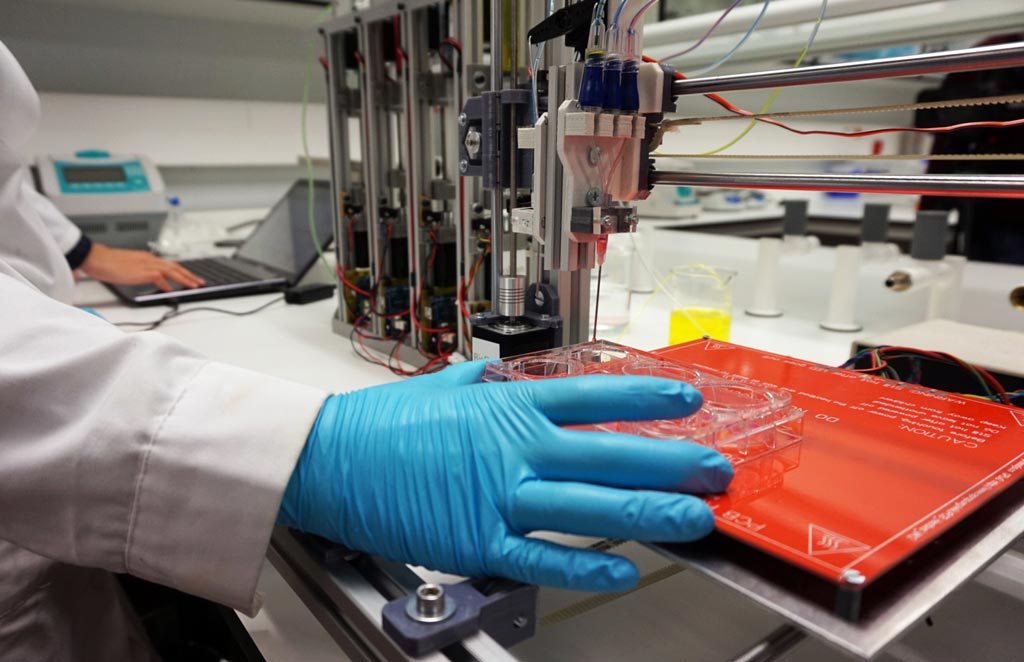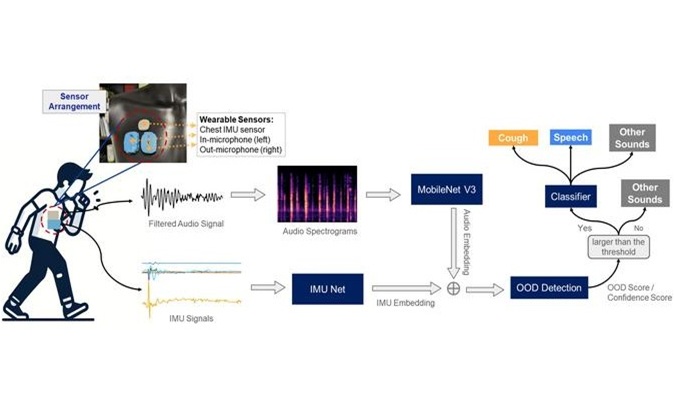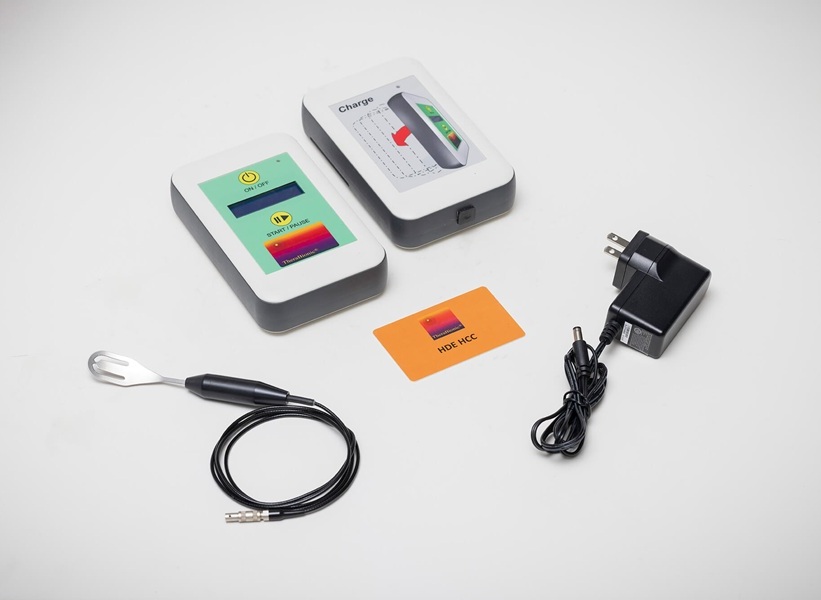3D Bioprinter Produces Functional Human Skin
|
By HospiMedica International staff writers Posted on 09 Feb 2017 |

Image: A novel 3D bioprinter prints bi-layered human skin (Photo courtesy of UC3M).
A novel three-dimensional (3D) printing technology uses human components to produce active skin that makes its own collagen.
Researchers at Hospital General Universitario Gregorio Marañón, Universidad Carlos III de Madrid, and other institutions 3D printed a human bilayered (epidermis and ermis) skin using bioinks containing human plasma, primary human fibroblasts, and keratinocytes obtained from skin biopsies. The researchers were able to generate 100 cm2--a standard P100 tissue culture plate--of printed skin in less than 35 min, including the 30 minutes required for fibrin gelation.
When using histological and immunohistochemical methods to analyze the structure and function of the printed skin in immunodeficient mice, they found that both in the 3D and in vitro cultures it was similar to human skin and, furthermore was indistinguishable from hand-made dermo-epidermal equivalents, which usually take three weeks to fabricate. The researchers claim that the human skin produced is adequate for transplant into patients, or for testing drugs and cosmetics. The study describing the technique was published on December 5, 2016, in Biofabrication.
“Knowing how to mix the biological components, in what conditions to work with them so that the cells don't deteriorate, and how to correctly deposit the product is critical to the system,” said study co-author Juan Francisco del Cañizo, MD, of Gregorio Marañón Hospital. “It prints the epidermis, including the stratum corneum, the protective outermost layer comprising keratinized cells. Then, it prints the deeper, thicker dermis, complete with fibroblasts that make collagen.”
“This method of bioprinting allows skin to be generated in a standardized, automated way, and the process is less expensive than manual production,” said Alfredo Brisac, CEO of BioDan Group, a private Spanish bioengineering firm that is commercializing the technology. “The 3D bioprinter has been submitted for approval by various European regulators. The approval is needed to ensure that the printed skin is suitable for transplanting into patients with burns and other skin conditions.”
Researchers at Hospital General Universitario Gregorio Marañón, Universidad Carlos III de Madrid, and other institutions 3D printed a human bilayered (epidermis and ermis) skin using bioinks containing human plasma, primary human fibroblasts, and keratinocytes obtained from skin biopsies. The researchers were able to generate 100 cm2--a standard P100 tissue culture plate--of printed skin in less than 35 min, including the 30 minutes required for fibrin gelation.
When using histological and immunohistochemical methods to analyze the structure and function of the printed skin in immunodeficient mice, they found that both in the 3D and in vitro cultures it was similar to human skin and, furthermore was indistinguishable from hand-made dermo-epidermal equivalents, which usually take three weeks to fabricate. The researchers claim that the human skin produced is adequate for transplant into patients, or for testing drugs and cosmetics. The study describing the technique was published on December 5, 2016, in Biofabrication.
“Knowing how to mix the biological components, in what conditions to work with them so that the cells don't deteriorate, and how to correctly deposit the product is critical to the system,” said study co-author Juan Francisco del Cañizo, MD, of Gregorio Marañón Hospital. “It prints the epidermis, including the stratum corneum, the protective outermost layer comprising keratinized cells. Then, it prints the deeper, thicker dermis, complete with fibroblasts that make collagen.”
“This method of bioprinting allows skin to be generated in a standardized, automated way, and the process is less expensive than manual production,” said Alfredo Brisac, CEO of BioDan Group, a private Spanish bioengineering firm that is commercializing the technology. “The 3D bioprinter has been submitted for approval by various European regulators. The approval is needed to ensure that the printed skin is suitable for transplanting into patients with burns and other skin conditions.”
Channels
Critical Care
view channel
Origami Robots to Deliver Medicine Less Invasively and More Effectively
Delivering medicine to ulcers or other internal sites often requires invasive procedures that can disrupt surrounding tissues and lengthen recovery times. Traditional magnetic actuators used in soft robotics... Read more
Improved Cough-Detection Technology Aids Health Monitoring
Coughing serves as an important biomarker for tracking a variety of conditions and can help monitor the progress of respiratory diseases or predict when someone’s asthma is being exacerbated.... Read moreSurgical Techniques
view channel
Novel Glue Prevents Complications After Breast Cancer Surgery
Seroma and prolonged lymphorrhea are among the most common complications following axillary lymphadenectomy in breast cancer patients. These postoperative issues can delay recovery and postpone the start... Read more
Breakthrough Brain Implant Enables Safer and More Precise Drug Delivery
Delivering medication directly to specific regions of the brain has long been a major challenge in treating neurological disorders. Current implants and infusion systems typically reach only one or two... Read morePatient Care
view channel
Revolutionary Automatic IV-Line Flushing Device to Enhance Infusion Care
More than 80% of in-hospital patients receive intravenous (IV) therapy. Every dose of IV medicine delivered in a small volume (<250 mL) infusion bag should be followed by subsequent flushing to ensure... Read more
VR Training Tool Combats Contamination of Portable Medical Equipment
Healthcare-associated infections (HAIs) impact one in every 31 patients, cause nearly 100,000 deaths each year, and cost USD 28.4 billion in direct medical expenses. Notably, up to 75% of these infections... Read more
Portable Biosensor Platform to Reduce Hospital-Acquired Infections
Approximately 4 million patients in the European Union acquire healthcare-associated infections (HAIs) or nosocomial infections each year, with around 37,000 deaths directly resulting from these infections,... Read moreFirst-Of-Its-Kind Portable Germicidal Light Technology Disinfects High-Touch Clinical Surfaces in Seconds
Reducing healthcare-acquired infections (HAIs) remains a pressing issue within global healthcare systems. In the United States alone, 1.7 million patients contract HAIs annually, leading to approximately... Read moreBusiness
view channel
Philips and Masimo Partner to Advance Patient Monitoring Measurement Technologies
Royal Philips (Amsterdam, Netherlands) and Masimo (Irvine, California, USA) have renewed their multi-year strategic collaboration, combining Philips’ expertise in patient monitoring with Masimo’s noninvasive... Read more
B. Braun Acquires Digital Microsurgery Company True Digital Surgery
The high-end microsurgery market in neurosurgery, spine, and ENT is undergoing a significant transformation. Traditional analog microscopes are giving way to digital exoscopes, which provide improved visualization,... Read more
CMEF 2025 to Promote Holistic and High-Quality Development of Medical and Health Industry
The 92nd China International Medical Equipment Fair (CMEF 2025) Autumn Exhibition is scheduled to be held from September 26 to 29 at the China Import and Export Fair Complex (Canton Fair Complex) in Guangzhou.... Read more














